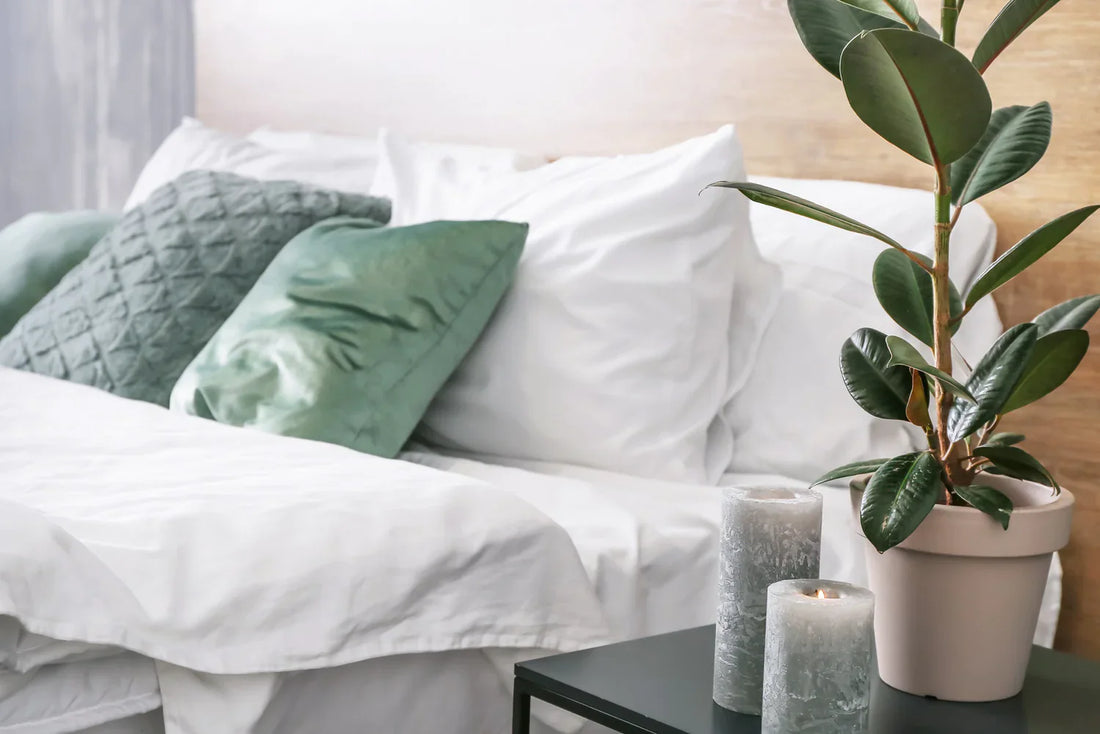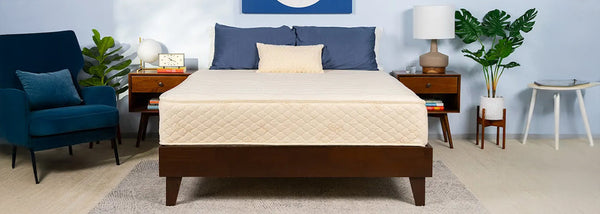10+ types of blankets all you need to know

Is there anything quite as satisfying as wrapping yourself in the warm embrace of a blanket on a frosty winter night? We think not. Yet, amidst the sheer diversity of blanket choices, how do you find the one that's made for you?
Indeed, different types of blankets have their merits and drawbacks. Your ideal blanket choice hinges on various factors, including your local climate, health considerations, personal inclinations, and lifestyle.
Delve further to uncover the differences between diverse blanket varieties and accumulate insight into what each can offer you.
What Is The Purpose Of A Blanket?
Before making a choice, it is essential to go through the key purposes of buying a blanket. Some purposes of a blanket include:
- Warmth: Blankets are primarily used to provide warmth during colder seasons or in chilly environments.
- Comfort: A soft and cozy blanket can offer comfort and a sense of security, making it easier to relax and unwind.
- Decoration: Blankets possess the power to transform spaces with a mere drape. They are functional and have artistic elements to add depth, colour, and texture to rooms. Whether draped across a sofa or elegantly folded on a bed, they tell a visual story.
- Versatility: Depending on the type of blanket, it can be used for various purposes. The different types of blankets elevate your living room, the warm layer that adorns your bed, and the comfort during outdoor adventures. They seamlessly transition from functional to fashionable.
- Gifts: When you gift a blanket, you're gifting comfort, warmth, and thoughtfulness. It's a gesture that speaks importance, conveying your care. Be it for celebrations or just a random act of kindness. A blanket is a timeless present showcasing thoughtfulness and practicality.
10 Different Types Of Blankets
When choosing blankets, there is a wide variety of options to choose from. Each type has unique features and benefits. Let's explore some types of bed blankets
1. Comforter
A comforter is a popular choice for types of blankets for beds. It is filled with polyfill, down, feathers, or cotton materials and covered with a soft fabric like cotton or polyester blend. Comforters are known for their warmth and fluffy appearance.
Pros:
- Provides ample warmth due to the filling material.
- It can be easily slipped into a duvet cover for easy cleaning and a change in appearance.
Cons:
- Some comforters require dry cleaning, especially if they are filled with feathers or down.
- Too warm for individuals living in a hot climate.
- Requires a top sheet, which some find uncomfortable.
2. Throw
A throw blanket is a smaller blanket primarily used for decoration and added warmth. It is often made from one layer of fabric and can be placed on a bed or draped over a sofa or chair. Throws come in various best types of blankets materials and styles, including knit, woven, or fleece.
Pros:
- Easy to switch up the look of a room by adding throw blankets in different colors.
- Perfect size for keeping warm in the living room or as an extra layer on the bed.
Cons:
- Small to use comfortably as the primary blanket on a bed.
3. Duvet
A duvet is a type of blanket that requires a duvet cover. It is typically filled with materials like down, feathers, polyester, or cotton and has ties on each corner to secure it to the cover. Duvets provide warmth and are easily customizable types of blankets for beds and duvet covers.
Pros:
- Duvet covers can be easily washed, eliminating the need for a top sheet.
- Easy to switch up the look of your bedding by changing the duvet cover.
Cons:
- Incorrect fit may cause the duvet to come loose from the cover and become lumpy.
3. Quilt
Quilts are types of blankets made from three layers of fabric: a top, a thin filling, and a back. The layers are stitched together to create unique designs. Quilts are known for their lightweight and decorative appearance.
Pros:
- Ideal for warmer climates or layering with other bed coverings due to their lightweight nature.
- Gives a smooth and sleek look on the bed.
Cons:
- Requires dry cleaning due to the delicate stitching and layers.
4. Sherpa Blanket
Sherpa blankets, expertly crafted from synthetic materials, boast a dual-sided composition. One side is smooth flannel, while the other side is plush fleece. All these types of blankets have garnered acclaim for their exceptional attributes, a combination of lightweight warmth and a luxuriously soft texture.
Pros:
- Lightweight yet warm.
- Plush fur-like feeling thanks to the fleece.
Cons:
- Some products may wear down after extended use and washing.
5. Chenille Blanket
A fusion of warmth and vintage elegance. Crafted from cotton, acrylic, or rayon, the blanket offers an exquisite tactile experience. Above their relaxing feature, they elicit a vintage tone, seamlessly blending utility with a retro aesthetic. Ideal for both comfort and decor, Chenille blankets present a timeless charm that wraps you in warmth and adorns your space with a touch of sophistication.
Pros:
- Highly decorative and warm.
- It adds a touch of vintage charm to any room.
Cons:
- Delicate and may require dry cleaning.
- Fibers can rub off and leave the blanket looking threadbare without proper care.
5. Cotton Blankets
Renowned for their hypoallergenic and breathable nature, cotton different types of blankets for beds stand as a pinnacle choice for individuals with sensitivities or allergies. Their versatility shines through year-round use, adapting seamlessly to shifting climates. They are available in different weaves, such as percale and sateen, which affect the texture and warmth of the blanket.
Pros:
- Hypoallergenic and breathable.
- Versatile for year-round use.
Cons:
- Require frequent washing to maintain cleanliness.
6. Wool Blankets
Wool blankets have been used for centuries due to their excellent insulation properties. Perfectly suited for colder climates, they have the unique feature to cover you in warmth while keeping the chill at bay. Available in knit or woven forms, often adorned with stylish fringes, they encapsulate utility and elegance.
Pros:
- Excellent insulators for colder climates.
- Breathable and durable.
Cons:
- Require special care and dry cleaning.
7. Fleece Blankets
Fleece blankets are a popular alternative to wool blankets. Crafted from polyester or cotton, their softness and anti-allergic properties make them an attractive pick. Offering a delicate balance between warmth and breathability, they are your dependable companions in various temperature settings.
Pros:
- Soft and lightweight.
- Anti-allergic properties.
Cons:
- May pill after extended use and washing.
8. Silk Blankets
Silk blankets epitomize elegance with each thread. The material is known for its natural sheen and smooth texture, lending a luxurious appearance to the blanket. This aesthetic charm elevates the ambience of any space, transforming an ordinary bedroom into a haven of refinement.
Pros:
- Silk blankets adapt to your body's temperature and provide warmth in cold weather and cooling in heat.
- The feather-light texture of silk blankets offers a luxurious and indulgent touch.
Cons:
- Silk blankets require gentle care to prevent damage, including hand washing and avoiding direct sunlight.
- The premium features of silk blankets often come at a higher price than other options.
Things To Consider When Buying A Blanket
When purchasing a blanket, there are important factors to consider to make the right choice. Here are some points to keep in mind:
-
Material
Consider the types of blankets materials, as they affect its texture, warmth, durability, and hypoallergenic properties. Each material has advantages and disadvantages, so choose one that suits your preferences, climate, and allergies or sensitivities.
-
Decor Needs
Think about the colour scheme and style of the room where you plan to use the blanket. Choose a colour or pattern that complements the existing decor or adds visual interest to the space.
-
Budget
Set a budget based on the material, quality, and brand you desire. Blanket prices vary widely, so determine your priorities and balance quality and cost that fits your necessities.
-
Reviews
Read customer reviews to gather information about the comfort, quality, and durability of the types of blankets. Reviews provide helpful insights from verified customers who have tried the product.
-
Size
Choose a blanket that fits your bed size or intended use. Consider whether you will be sharing the blanket and ensure it is large enough to accommodate comfortably.
-
Warmth and Insulation
Consider the insulation properties of the blanket based on your climate and personal preferences. Heavier blankets provide warmth, while lighter materials are more breathable and suitable for warmer temperatures. - Care and Maintenance
Check the manufacturer's care instructions for washing, drying, and storage requirements. Some materials require special care or are prone to wear and tear if improperly maintained. Choose a blanket that is easy to care for if you prefer a low-maintenance option.
Conclusion
Blankets are no longer mere coverings; they offer utmost comfort and eclectic style. From the luxurious texture of Sherpa to the delicate craftsmanship of quilts, every types of blankets exudes a unique charm. Keep in mind that selecting the perfect blanket is a reflection of your discerning taste and a statement of comfort and elegance.
FAQs
- What is the warmest type of blanket?
The warmest type of blanket depends on the material and weight. Materials like wool and down provide excellent insulation and are known for their warmth. Additionally, blankets with multiple layers or thicker construction tend to be warmer.
- Can I use a throw blanket as bedding?
Throw blankets are typically smaller in size and may not provide sufficient coverage for a bed mattress. They can be used as an extra layer or decorative element on top of bedding but are not suitable as the primary blanket for a bed.
- How do I clean my blanket?
Care instructions for cleaning blankets vary depending on the material. Check the manufacturer's instructions for specific guidance. Some blankets can be machine-washed, while others require dry cleaning or special care.







